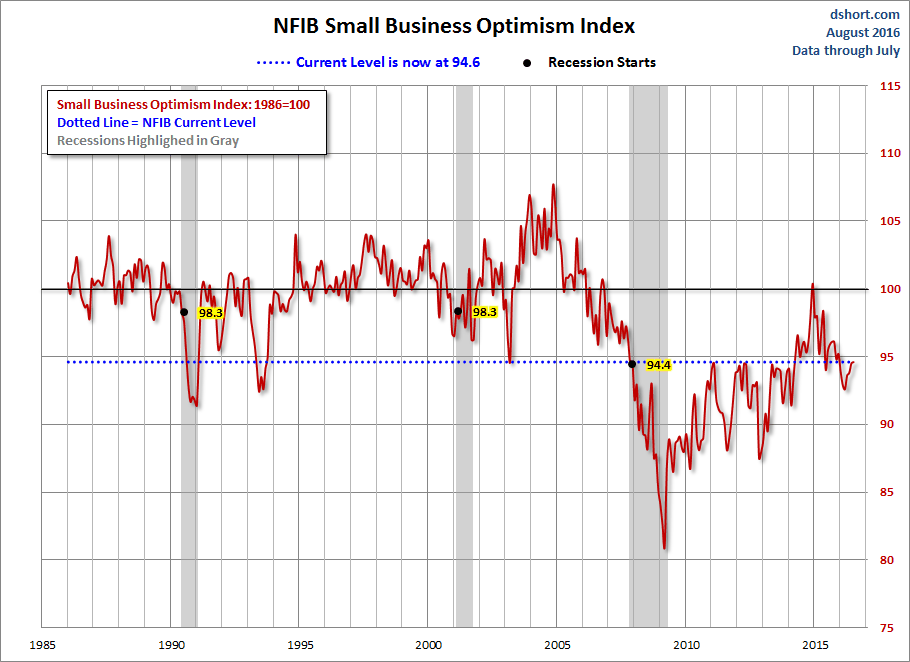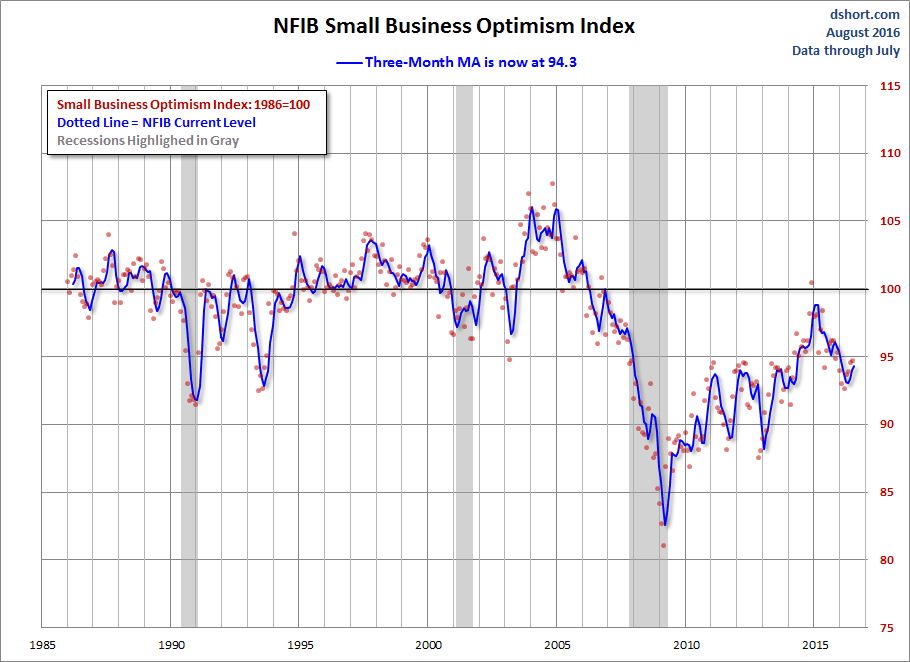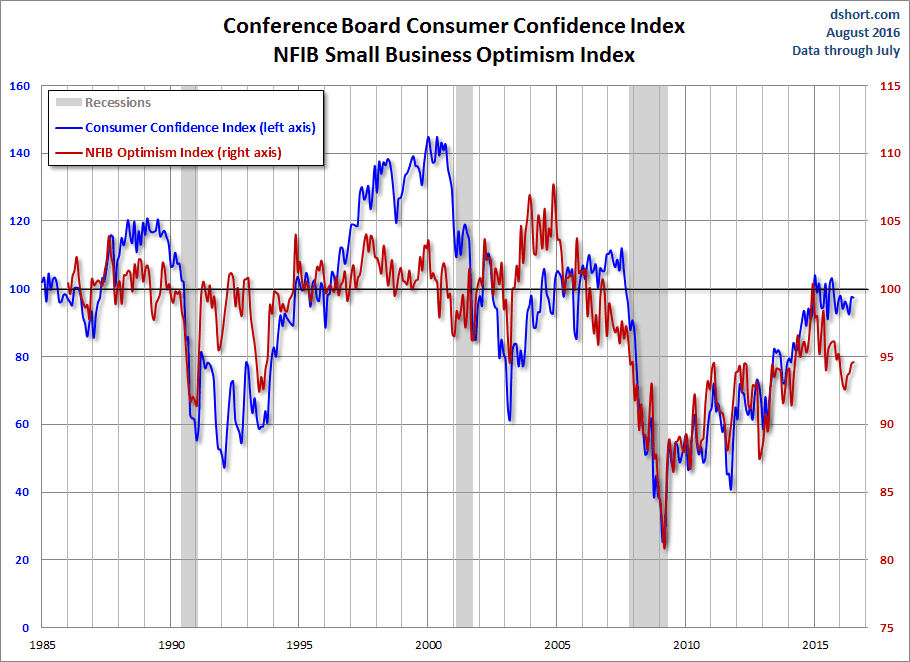The latest issue of the NFIB Small Business Economic Trends came out yesterday (available here). The August update for July came in at 94.1, up 0.6 points from the previous month. Yesterday's overall number is at the 20.5 percentile in this series -- fractionally above the top of the lowest quintile in the history of this series. Since its initial recovery following its Great Recession trough, this index has been stuck in an extremely volatile range for the past three years. Since January of 2011, it has repeatedly bumped a ceiling fractionally above its current level and then retreated.
Here is an excerpt from the opening summary of the report:
Small business optimism sighed in July, with NFIB's monthly Index increasing just over half a point (0.6) for a total reading of 94.1. This month's report continues the historically weak trend of owner confidence which has led some observers to suggest that Index should be renamed Small Business Pessimism Index. On the positive front, while the two labor market indicators remained weak, both improved and are beginning to push into "normal" territory. But uncertainty about the future remains endemic among jobs creators, only nine percent of respondents think that now is a good time to expand their businesses.
"In an attempt to 'make lemonade' from the lousy bushel of lemons the administration has handed the small-business community, owners gave the July optimism Index the great distinction of being the fourth highest reading since December 2007 -- when the economy slipped into official recession. But let's not get too excited: The level is still well below the average reading of 100 in the prior 35 years and still half a point below the December 2007 reading. Unfortunately, nothing is being done to allay the most pressing concerns identified by job creators—dealing with rising health insurance costs, regulations, tax complexity, energy costs and general economic uncertainty. The President wants a deal on 'corporate taxes', but most small businesses are not incorporated. Energy policy is more confused than ever and the volume of new regulations is mounting. Should I even mention the mounting problems with Obamacare? We are in the 'tankeroo,' not sinking, but trying to stay afloat." NFIB chief economist Bill Dunkelberg
The first chart below highlights the 1986 baseline level of 100 and includes some labels to help us visualize that dramatic change in small-business sentiment that accompanied the Great Financial Crisis. Compare, for example the relative resilience of the index during the 2000-2003 collapse of the Tech Bubble with the far weaker readings of the past four years. The NBER declared June 2009 as the official end of the last recession.
The average monthly change in this indicator is 1.29 points. To smooth out the noise of volatility, here is a 3-month moving average of the Optimism Index along with the monthly values, shown as dots.
Inventories And Sales
The findings on small business inventories and sales continue to underscore the general pessimism of the survey. The excerpts below are from the latest monthly report (PDF format).
The net percent of all owners (seasonally adjusted) reporting higher nominal sales in the past 3 months compared to the prior 3 months improved one point, rising to a negative 7 percent. Sixteen (16) percent still cite weak sales as their top business problem, historically high, but far better than the record 34 percent reading last reached in March 2010. The net percent of owners expecting higher real sales volumes rose 2 points to 7 percent of all owners (seasonally adjusted), 7 points below the cycle high of a net 14 percent reached in February 2011, and that was a poor reading. These expectations are not the kind that will generate a lot of new employment or new orders for inventories.
The pace of inventory reduction continued, with a net negative 10 percent of all owners reporting growth in inventories (seasonally adjusted), 3 points worse than June. For all firms, a net negative 1 percent (a 1 point improvement) reported stocks too low. The net percent of owners planning to add to inventory stocks was unchanged at a negative 1 percent, in line with rather poor expectations for sales growth.
Credit Markets
Has the Fed's zero interest rate policy and quantitative easing had a positive impact on Small Businesses?
Five percent of the owners reported that all their credit needs were not met, unchanged and the lowest reading since February, 2008. Thirty (30) percent reported all credit needs met. Only 3 percent reported that financing was their top business problem compared to 21 percent citing taxes.
NFIB Commentary
This month's "Commentary" section concludes with the following observations about the "bifurcated" economy:
The amazing stock market continues to surge ahead, even as prospects for earnings growth fade. On Main Street, there is no evidence of profit growth. The economy remains bifurcated, exports turned in a good performance, mostly activity for the large manufacturers, energy companies and agribusiness. Sales for small businesses, especially at service firms, continue to languish. Job openings improved, signaling a tightening in labor markets due as much to departures from the labor force as to the creation of new jobs (of which there were few). But this puts downward pressure on the unemployment rate. Plans to create new jobs also advanced, in spite of pessimistic views of future sales growth, but still historically low and not typical of periods of economic growth.
Business Optimism and Consumer Confidence
The next chart is an overlay of the Business Optimism Index and the Conference Board Consumer Confidence Index. The consumer measure is the more volatile of the two, so I've plotted it on a separate axis to give a better comparison of the volatility from the common baseline of 100. 
These two measures of mood have been highly correlated since the early days of the Great Recession, although we see a bit of contrast in the latest readings of the two. Consumer Confidence has generally been trending higher since its post-recession trough in 2011, but Small Business keeps bumping a ceiling just above its current level. It will be particularly interesting to see if the consumer's increasing optimism can spill over into Small Business.
- English (UK)
- English (India)
- English (Canada)
- English (Australia)
- English (South Africa)
- English (Philippines)
- English (Nigeria)
- Deutsch
- Español (España)
- Español (México)
- Français
- Italiano
- Nederlands
- Português (Portugal)
- Polski
- Português (Brasil)
- Русский
- Türkçe
- العربية
- Ελληνικά
- Svenska
- Suomi
- עברית
- 日本語
- 한국어
- 简体中文
- 繁體中文
- Bahasa Indonesia
- Bahasa Melayu
- ไทย
- Tiếng Việt
- हिंदी
Small Business Sentiment: Fractionally Higher, Historically Weak
Published 08/14/2013, 02:23 AM
Updated 07/09/2023, 06:31 AM
Small Business Sentiment: Fractionally Higher, Historically Weak
3rd party Ad. Not an offer or recommendation by Investing.com. See disclosure here or
remove ads
.
Latest comments
Install Our App
Risk Disclosure: Trading in financial instruments and/or cryptocurrencies involves high risks including the risk of losing some, or all, of your investment amount, and may not be suitable for all investors. Prices of cryptocurrencies are extremely volatile and may be affected by external factors such as financial, regulatory or political events. Trading on margin increases the financial risks.
Before deciding to trade in financial instrument or cryptocurrencies you should be fully informed of the risks and costs associated with trading the financial markets, carefully consider your investment objectives, level of experience, and risk appetite, and seek professional advice where needed.
Fusion Media would like to remind you that the data contained in this website is not necessarily real-time nor accurate. The data and prices on the website are not necessarily provided by any market or exchange, but may be provided by market makers, and so prices may not be accurate and may differ from the actual price at any given market, meaning prices are indicative and not appropriate for trading purposes. Fusion Media and any provider of the data contained in this website will not accept liability for any loss or damage as a result of your trading, or your reliance on the information contained within this website.
It is prohibited to use, store, reproduce, display, modify, transmit or distribute the data contained in this website without the explicit prior written permission of Fusion Media and/or the data provider. All intellectual property rights are reserved by the providers and/or the exchange providing the data contained in this website.
Fusion Media may be compensated by the advertisers that appear on the website, based on your interaction with the advertisements or advertisers.
Before deciding to trade in financial instrument or cryptocurrencies you should be fully informed of the risks and costs associated with trading the financial markets, carefully consider your investment objectives, level of experience, and risk appetite, and seek professional advice where needed.
Fusion Media would like to remind you that the data contained in this website is not necessarily real-time nor accurate. The data and prices on the website are not necessarily provided by any market or exchange, but may be provided by market makers, and so prices may not be accurate and may differ from the actual price at any given market, meaning prices are indicative and not appropriate for trading purposes. Fusion Media and any provider of the data contained in this website will not accept liability for any loss or damage as a result of your trading, or your reliance on the information contained within this website.
It is prohibited to use, store, reproduce, display, modify, transmit or distribute the data contained in this website without the explicit prior written permission of Fusion Media and/or the data provider. All intellectual property rights are reserved by the providers and/or the exchange providing the data contained in this website.
Fusion Media may be compensated by the advertisers that appear on the website, based on your interaction with the advertisements or advertisers.
© 2007-2024 - Fusion Media Limited. All Rights Reserved.
